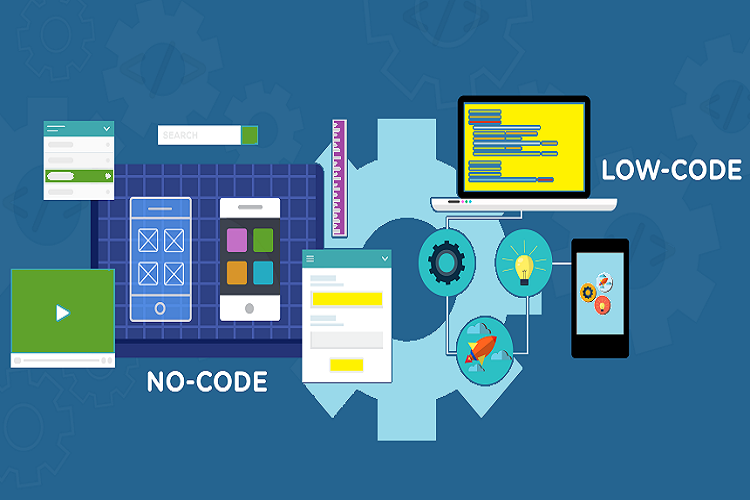
Over the last couple of years, drag and drop platforms, also known as low-code or no-code platforms, have gained immense popularity amongst enterprises to build great applications for mobile and web and automate processes without any significant manual efforts.
While low code and no-code platforms aren't entirely a new phenomenon, the pandemic-driven dynamics have pushed many enterprises to extensively test these platforms to elevate customer experience and digitize company-wide operations. These drag and drop interfaces often come with AI and ML-based integrated applications, with built-in integration and databases, offering ready-to-use templates for enterprises who want to build applications and automate processes without engaging developers to write the HTML or iOS code.
A Gartner forecast projects that the worldwide low-code development technologies market is expected to reach USD 13.8 billion in 2021, primarily driven by the surge in the remote working model during the COVID-19 pandemic. Another study by Forrester anticipates that the no-code development platform market will grow from USD 3.8 billion in 2017 to USD 21.2 billion by 2022. These are massive projections.
Last year, Google acquired AppSheet to bring code-free development to the Google cloud and enable its customers to develop mobile apps without writing a line of code. This was considered a significant development since Google tried its hands in the no-code/low code solution offerings without much success. Other technology companies, such as Microsoft, Amazon, ServiceNow, Infosys, and HCL Technologies are rapidly building their low-code and no-code solution capabilities. All this indicates that the low-code and no-code platforms are now becoming mainstream.
However, many enterprises still fail to get the desired functionality they want from the low-code development ecosystems despite the excitement and massive growth projections. In the past, IT decision-makers who have rushed to deploy low code/ no-code platforms to accelerate their digital transformation journeys had to master their learning curve before reaping any significant advantages.
Limited availability of templates
Many vendors and solutions providers have been marketing their low-code/no-code tools as the simplest way of application development and workflow management, even when the company doesn't have enough technical knowledge or resources. IT decision-makers, however, need to consider various factors before immediately implementing these tools. One of the biggest challenges that codeless platforms have is the limited availability of patterns to choose from. Companies often design these pre-built app templates to create web and mobile applications with specific use-cases.
Enterprises that need moderate to extensive customization should have the in-house talent to scale the applications. In low-code platforms, IT decision-makers should ensure that they have a certain level of coding skills to support apps' development. It is likewise essential to note that every tool has some constraints, and if you've not planned about the final result that you want to achieve, the chances of getting complex and costly workarounds when scaling up the app remain high.
Security and governance issues
For years, many enterprises have been trying and testing the low-code and no-code platforms to solve the problems quickly and democratize the technology. These platforms have been beneficial for businesses that do not have the requisite budget to hire software developers or outsourcing agencies to develop the necessary cloud infrastructure. While employees can quickly learn the deployment of these platforms, unlike custom development, these platforms may not give complete control to IT heads regarding security and governance issues. There are various risks involved, such as a no-code/low-code solution provider getting acquired by a third company or non-technical experts developing applications that may include critical customer data.
According to Forrester, currently, about 12% of enterprises manage their processes using low-code tools. There are still many hang-ups since the investments in legacy systems have been on a higher side. Transitioning to pre-configured modules and functionality is also not without risks. Without any coding expert, the chances of putting insecure codes remain high, and sophisticated hackers can leverage that to obtain sensitive organizational data.
In the complex ecosystem of contending vendors, organizations must select a solution provider with full-proof built-in security capabilities. IT decision-makers should remember that even if they are using a third-party tool, the responsibility of securing the data lies with the enterprise. The vendor should provide the security certifications and necessary governance models to effectively run the no-code/low-code platform.
Scaling related challenges
One of the essential factors that IT decision-makers should keep in mind when choosing a low-code/no-code development platform is an in-depth analysis of application scaling. In most no-code/low code cases, the platforms become too stiff or restraining to accommodate desired functionalities promptly.
The majority of these drag and drop platform works exceptionally well in a small set-up with a limited set of users. However, the real challenge comes, especially in large set-ups when businesses want to scale. This is a common challenge faced by organizations and in-house developers. If more customization is needed based on user feedback, even the no-code or low code platforms have to be extensively built. Technology leaders must assess suppliers' ability to provide ready-to-use solutions when needed while scaling up software or internal client applications.
Most importantly, while picking a low-code/no-code partner, organizations should keep in mind that there could be a restriction of working with the larger firms, such as Google, Microsoft, and Salesforce. They may not allow application development processes beyond their environments. On the other hand, many other small solution providers may offer plenty of options to develop no-code/low code applications, even in the on-premises environment.
An ideal no or low code platform should enable the organization and IT decision-makers to achieve their business goals without compromising security while ensuring the functionality can be scaled up in case of a requirement. For a winning no-code/low code technology strategy, an organization needs to carefully analyze which platform they want to commit to and whether there is a precise alignment between business goals.

 In
In
Add new comment